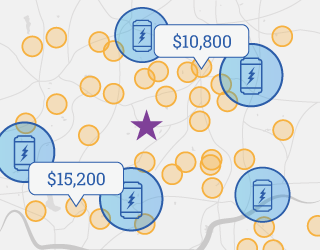In 2020, Tesla announced that they would be manufacturing their Model 3 cars in China using lithium iron phosphate (LFP) batteries, moving away from their traditional nickel-based chemistries they use in US-based car manufacturing. Tesla doubled down on their bet on iron batteries in the spring of 2021, announcing intent to use LFP batteries in their grid-scale energy storage solution: the Megapack.
Key takeaways
- Tesla is moving to lithium iron phosphate (LFP) chemistry for their Megapack battery product
- This signals a move for the company and potentially the storage industry as a whole towards LFP technology over cobalt/nickel-based batteries
- Home batteries are still mostly based on cobalt – you can compare your options on the EnergySage Marketplace
What products will Tesla now produce with LFP battery cells?
On the energy storage front, Tesla will now make its Megapack with iron-based battery cells. The Megapack is a three megawatt-hour (MWh) battery that stores large amounts of electricity on the grid. Tesla’s website advertises the Megapack as being applicable for “giga-scale projects” that can supply thousands of homes with electricity. It works best when paired with a non-dispatchable renewable resource like wind or solar to help deal with the intermittency of these resources – meaning when the sun isn’t shining, a solar plant with a Megapack installation on site can still discharge stored electricity to the grid.
Tesla already ships it’s Chinese-made Model 3 cars with LFP batteries, but CEO Elon Musk has hinted that the company is looking to expand the products it uses with LFP batteries over time. Two-thirds of all Tesla vehicles will allegedly get a battery with “iron chemistry” – a.k.a. LFP cells – and one-third will be planned with a nickel-heavy chemistry.
Beyond Chinese-made Model 3 cars and the Megapack, Tesla doesn’t currently use LFP batteries in any other products. As we mentioned above, however, they seem to be prioritizing LFP chemistries in a larger swath of their cars, and we could potentially even see LFP chemistries in other storage products from Tesla, like the Powerpack and popular Powerwall home battery.
Why is Tesla moving towards LFP battery chemistries?
The primary reason for a big company like Tesla to shift towards iron-based batteries is cost. Although they’re more energy-dense, nickel and cobalt-based batteries rely on more expensive materials (namely cobalt, as it’s not nearly as abundant as the materials needed for an LFP battery). This drives up the price of manufacturing and the end price of batteries. As Tesla continues to try and bring affordable storage and electric vehicle products to market, filling them with less expensive components is one clear path forward.
What Tesla’s shift to LFP means for you
For renters and homeowners, Tesla’s decision to start increasing their use of LFP battery cells won’t impact you. At the end of the day, both LFP and nickel-based batteries are safe and effective at storing electricity, and your home batteries and electric cars will work just the same. Down the line Tesla’s car prices may drop a little, as LFP batteries are less expensive to produce, but it’s hard to say by exactly how much or when.
Are LFP batteries the future of energy storage?
Tesla certainly thinks so, at least at the “giga” scale. Cobalt-based batteries are more energy dense than iron-based options, meaning they can store more electricity in a smaller physical space, but space doesn’t matter as much for large-scale storage installations. Home batteries like the Tesla Powerwall might still rely on non-iron chemistries for a while, as the compact nature of those products can be a big selling point. But for low to mid-performance electric cars and grid-scale energy storage, LFP may be the way of the future.
Compare your solar and storage options on EnergySage
Battery chemistry aside, there are plenty of factors to consider when choosing a home battery or solar panel system to install. The best way to make sure you’re getting the best deal? Compare multiple options on the EnergySage Marketplace. On EnergySage, installers compete for your business, so you can know you’re getting quoted high quality products for competitive prices. Start your home energy journey today.






